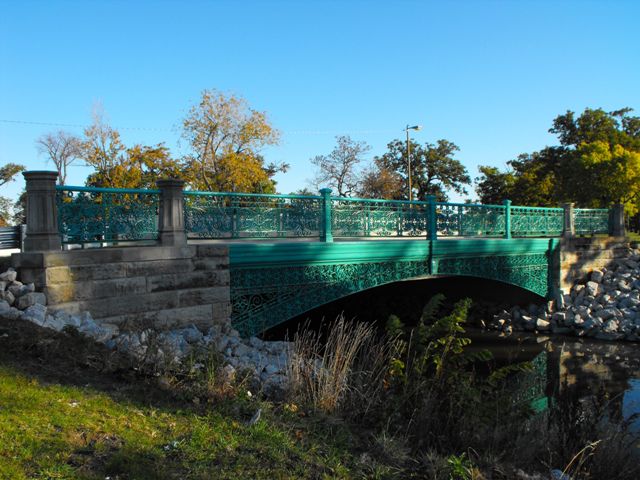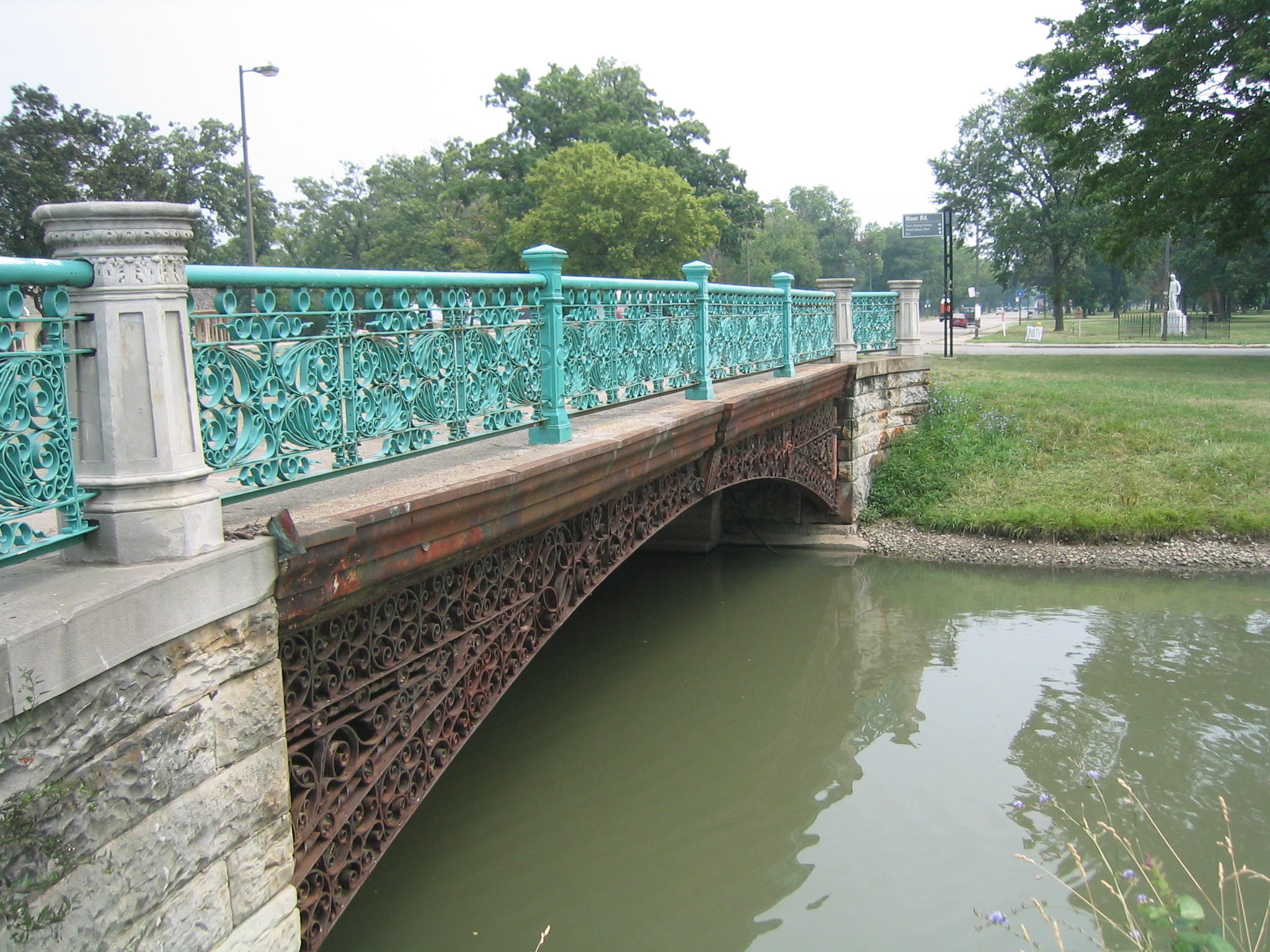We Recommend:
Bach Steel - Experts at historic truss bridge restoration.
BridgeHunter.com Phase 1 is released to the public! - Visit Now
Central Avenue Bridge

Primary Photographer(s): Nathan Holth
Bridge Documented: July 27, 2003 and October 10, 2009
Detroit: Wayne County, Michigan: United States
1893 By Builder/Contractor: King Bridge Company of Cleveland, Ohio
2008
50.0 Feet (15.2 Meters)
54.8 Feet (16.7 Meters)
49 Feet (14.94 Meters)
1 Main Span(s)
825180801056B01

View Information About HSR Ratings
Bridge Documentation
This bridge has been altered, resulting in a severe loss of historic integrity and significance!
View Archived National Bridge Inventory Report - Has Additional Details and Evaluation
This historic bridge's superstructure was demolished and replaced in 1947 and again in 2008, and only ornamental elements remain!
This ornate bridge is on one of the main roads on Belle Isle. It was built in 1893 by the King Bridge Company, However, historic significance is hurt by the fact that its original arched built-up riveted beams were replaced in 1947 with traditional rolled stringers, although the bridge retained its original general appearance including substructure and stunningly elaborate ornamentation. The railings on this bridge are extremely ornate, along with the decorative arch which is not structural, and these were retained in 1947. Stone abutments were apparently replaced in 1947, but the stones from the original abutment were left in place around the concrete abutment, so that the bridge retained the appearance of the stone abutments. The bridge stumped Michigan's historic bridge inventory, since their discussion implies that they thought the bridge was originally built as a stringer bridge. However a historical photo clearly shows arched beams under the bridge, demonstrating that the bridge was originally a steel deck arch structure. In 2008, the superstructure was again replaced, this time with a pre-stressed concrete adjacent box beam structure. As in 1947, the ornamental arch and railing were retained. Again the abutments were replaced, and again the stone facing was retained for aesthetic purposes. The 2008 replacement really did not make anything worse, since the 1947 superstructure it replaced was not original either. Retaining the stone facing, arch facade, and railing is about all that could be done. The railing and arch were cleaned and repainted during the project.
This bridge is a sister to the nearby Casino Bridge.
Above: Historical photo of bridge. To the right is an enlarged and enhanced detail of the photo showing an arched, riveted built-up beam, clearly showing that this bridge was not originally constructed as a stringer. Photo Source: Library of Congress.
Information and Findings From Michigan Historic Bridge InventoryNarrative Description The steel-stringer structure of the Central Avenue Bridge is disguised by an ornate metal grill, which makes the bridge appear to be a metal arch. Coursed ashlar forms the wing walls. Octagonal stone posts, trimmed with acanthus leaf and other designs, and decorated metal posts hold the ornate metal railing panels. The following is inscribed in the northwest and southeast end posts: "When the bridge was rebuilt in 1946, city engineers were careful to retain the arched metal fascia and the original railings and posts. In September 1879, the city of Detroit purchased Belle Isle, a 707-acre island in the Detroit River. By 1940, fill had expanded its size to nearly 1,000 acres. According to local historian Clarence M. Burton, it was originally "an unimproved area, abounding in native forests, sloughs, swales and was very unattractive." The city hired prominent landscape architect Frederick Law Olmstead for $7,000 per year to plan and oversee improvements. His layout included a central driveway, Central Avenue, and the canal that meanders around the island. A casino opened on the island in 1877, giving a name to another of the island's roads. The Central Avenue Bridge was similar in appearance to another which was apparently built on the island at the same time, but is no longer in extant. Arched girders comprised the structure of the other bridge, which was the subject of a favorable article in The Engineering Record in May 1893. The article observed that most bridge design was ruled by economy, resulting in utilitarian structures that lacked "any opportunity for graceful effects, or pleasing or ornamental outlines." A more picturesque option, masonry arches, cost significantly more and took longer to erect. Belle Isle's arched girder bridge "relieve(d) the square severity of the straight girders and secure(d) a more pleasing effect with our materially increasing the necessary cost." The Central Avenue Bridge, on the other hand, achieved a picturesque appearance by screening the structural stringers with an ornate arched fascia. Both bridges were produced by the King Bridge Company of Cleveland, Ohio, it is not clear why two designs were employed for bridges of equal span, built at about the same time. |
![]()
Photo Galleries and Videos: Central Avenue Bridge
2009 Bridge Photo-Documentation
Original / Full Size PhotosA collection of overview and detail photos, taken October 10, 2009, after a reconstruction project. This gallery offers photos in the highest available resolution and file size in a touch-friendly popup viewer.
Alternatively, Browse Without Using Viewer
![]()
2009 Bridge Photo-Documentation
Mobile Optimized PhotosA collection of overview and detail photos, taken October 10, 2009, after a reconstruction project. This gallery features data-friendly, fast-loading photos in a touch-friendly popup viewer.
Alternatively, Browse Without Using Viewer
![]()
2003 Bridge Photo-Documentation
A collection of overview and detail photos, taken July 27, 2003. This photo gallery contains a combination of Original Size photos and Mobile Optimized photos in a touch-friendly popup viewer.Alternatively, Browse Without Using Viewer
![]()
Maps and Links: Central Avenue Bridge
Coordinates (Latitude, Longitude):
Search For Additional Bridge Listings:
Bridgehunter.com: View listed bridges within 0.5 miles (0.8 kilometers) of this bridge.
Bridgehunter.com: View listed bridges within 10 miles (16 kilometers) of this bridge.
Additional Maps:
Google Streetview (If Available)
GeoHack (Additional Links and Coordinates)
Apple Maps (Via DuckDuckGo Search)
Apple Maps (Apple devices only)
Android: Open Location In Your Map or GPS App
Flickr Gallery (Find Nearby Photos)
Wikimedia Commons (Find Nearby Photos)
Directions Via Sygic For Android
Directions Via Sygic For iOS and Android Dolphin Browser
USGS National Map (United States Only)
Historical USGS Topo Maps (United States Only)
Historic Aerials (United States Only)
CalTopo Maps (United States Only)




